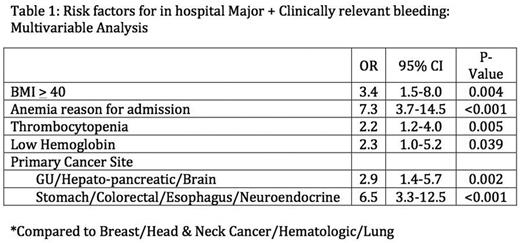Abstract
Background: Bleeding and thrombosis are both major complications of hospitalization in cancer patients. We have previously shown that rate of inpatient venous thromboembolism (VTE) is 4% in a general oncology population (Patell et al, ASCO 2016). Concern regarding bleeding risk may reduce compliance with thromboprophylaxis. A better understanding of predictors of bleeding could optimize use of prophylaxis but there remain major knowledge gaps regarding risk factors for in-hospital bleeding in cancer patients. We assessed major and clinically relevant bleeding incidence and identified risk factors at admission associated with subsequent in-hospital bleeding risk in a cohort of hospitalized cancer patients.
Methods: We conducted a retrospective cohort study of consecutive adults admitted to general oncology floor at Cleveland Clinic from 2013-14 (n= 3466). Patients were excluded for bleeding on admission (108). Data collected included demographics, body mass index (BMI), cancer type, length of stay (LOS), use of anticoagulants and baseline laboratory values (+48 hours). Bleeding was assessed using the ISTH definitions of major bleeding and clinically relevant non-major bleeding [Schulman 2005 and Decosus 2011]. Data were collected using an electronic query system of electronic health records. Reason for admission and all bleeding events were confirmed by manual chart review. Univariate risk factors were identified with logistic regression analysis. Multivariable risk factors were identified with stepwise logistic regression and confirmed with bootstrap analysis. Results are summarized as odds ratio (OR) and 95% confidence interval (CI).
Results: The study population comprised 3,358 patients of whom 69 (2.1%) developed major and clinically relevant non-major bleeding during hospitalization. Median age was 62 (range, 19-98) years and 56% were male. Median length of stay (LOS) was 5 (range, 0-152) days. The majority of bleeding events were either gastrointestinal (N=30, 43%) or intracranial (N= 13, 19%). In univariate analysis, luminal gastrointestinal (GI) cancers (OR 4.2, CI 2.4-7.5, P<0.001), anemia as reason for admission (OR 9.1, CI 5.1-16.4, P<0.001), thrombocytopenia (OR 1.6, CI 1.0-2.6, P=0.046), leukocytosis (OR 2.1, CI 1.2-3.7,P=0.005), low hemoglobin (OR 3.2, CI 1.4-7.1 P=0.003), BMI ≥ 40 kg/m2 (OR 2.6, CI 1.1-5.94, P=0.018) and anticoagulant use on admission (OR 0.4, CI 0.3-0.8, P=0.004) were significantly associated with bleeding. In multivariable analysis, anemia as the reason for admission, primary cancer site, BMI>40, thrombocytopenia and low hemoglobin on admission remained predictive of bleeding (table 1).
Conclusion: The incidence of major and clinically relevant bleeding in a large population of hospitalized cancer patients was about 2%, compared to incidence of inpatient VTE in a similar population of 4%. Risk factors at admission included type of cancer and morbid obesity. Improved prediction of bleeding risk can assist physicians in optimizing selection of thromboprophylaxis in this population that is also at increased risk of VTE.
Khorana:Sanofi: Consultancy, Honoraria; Leo: Consultancy, Honoraria, Research Funding; Amgen: Consultancy, Honoraria, Research Funding; Bayer: Consultancy, Honoraria; Halozyme: Consultancy, Honoraria; Pfizer: Consultancy, Honoraria; Roche: Consultancy, Honoraria; Janssen Scientific Affairs, LLC: Consultancy, Honoraria, Research Funding.
Author notes
Asterisk with author names denotes non-ASH members.


This feature is available to Subscribers Only
Sign In or Create an Account Close Modal